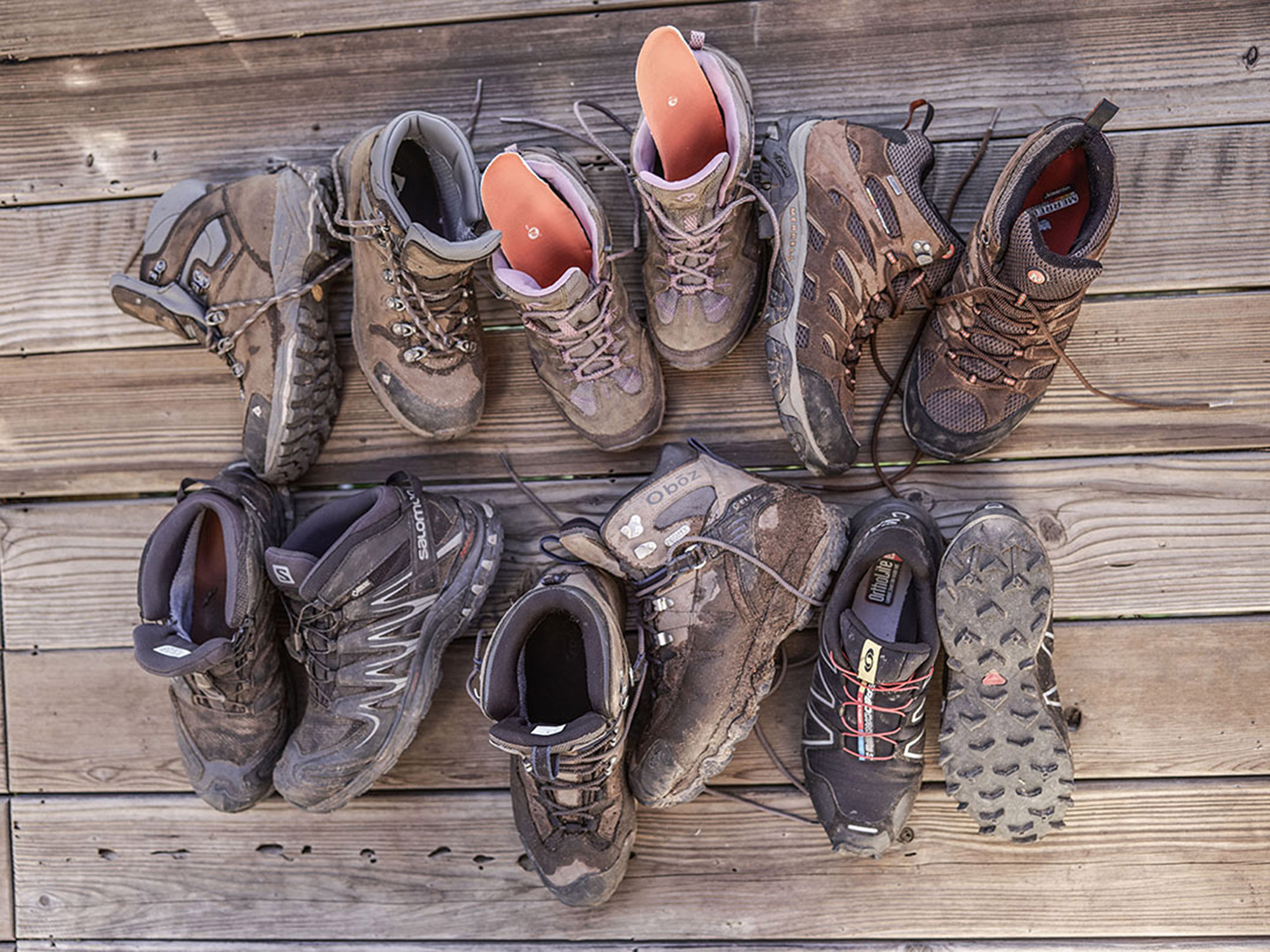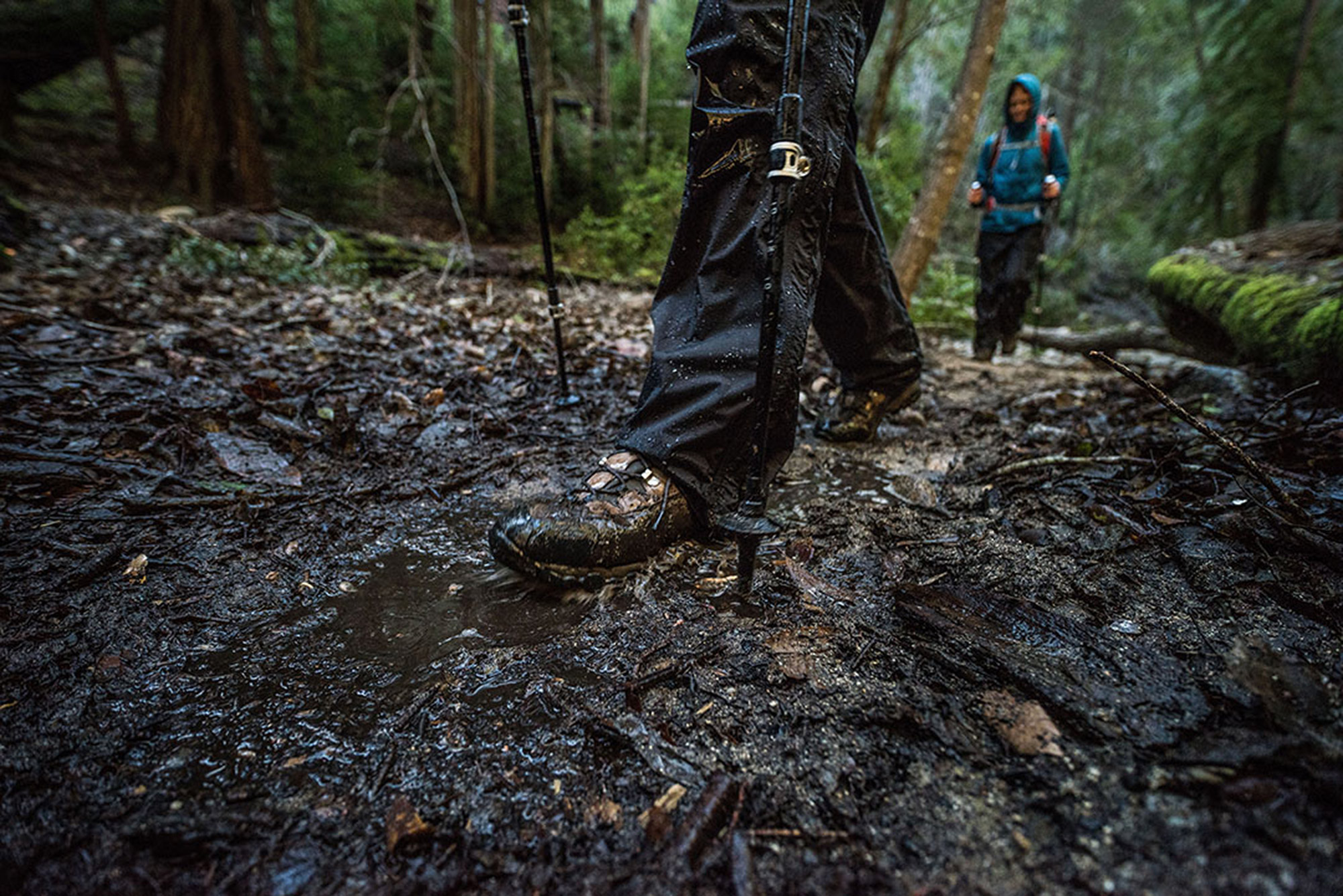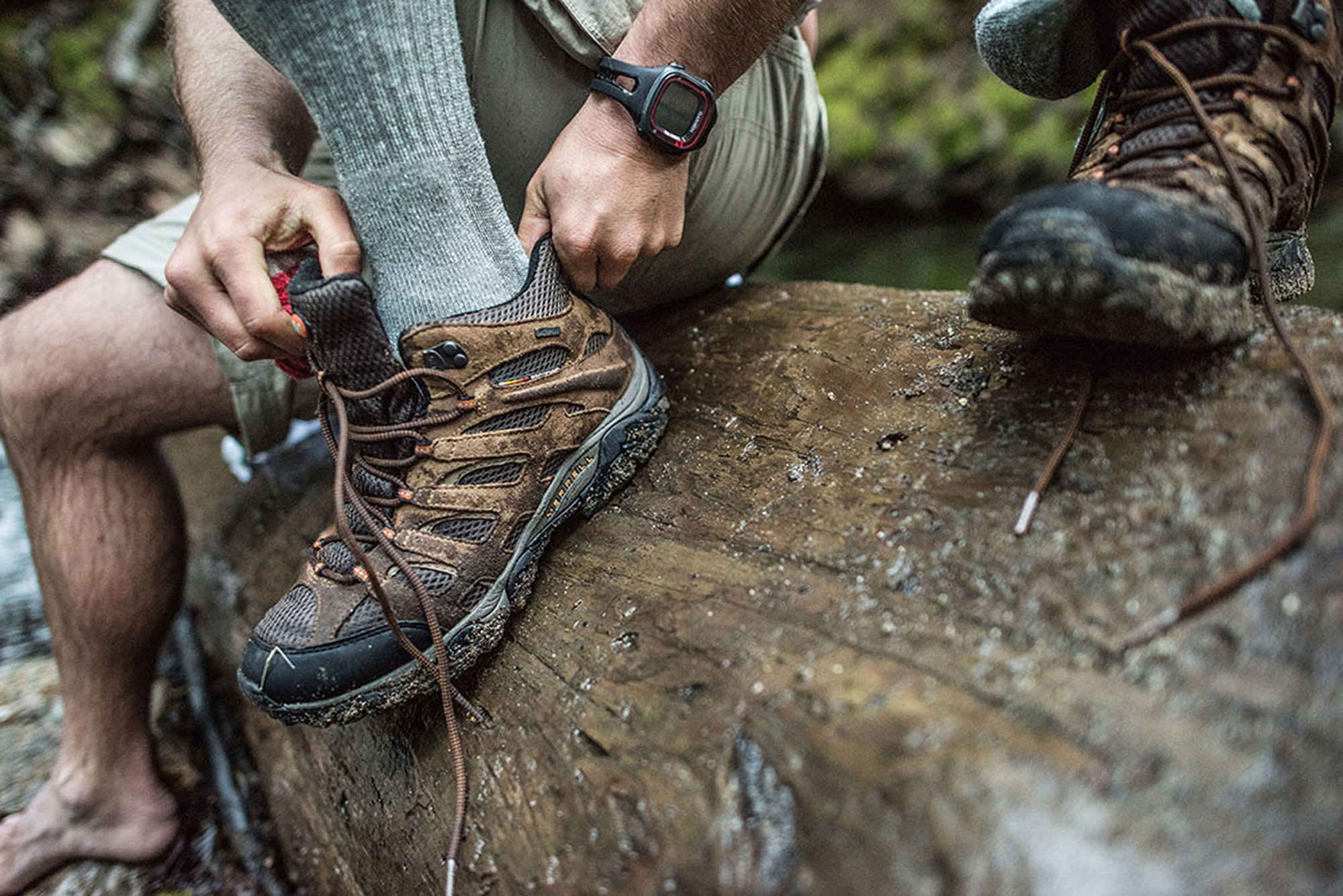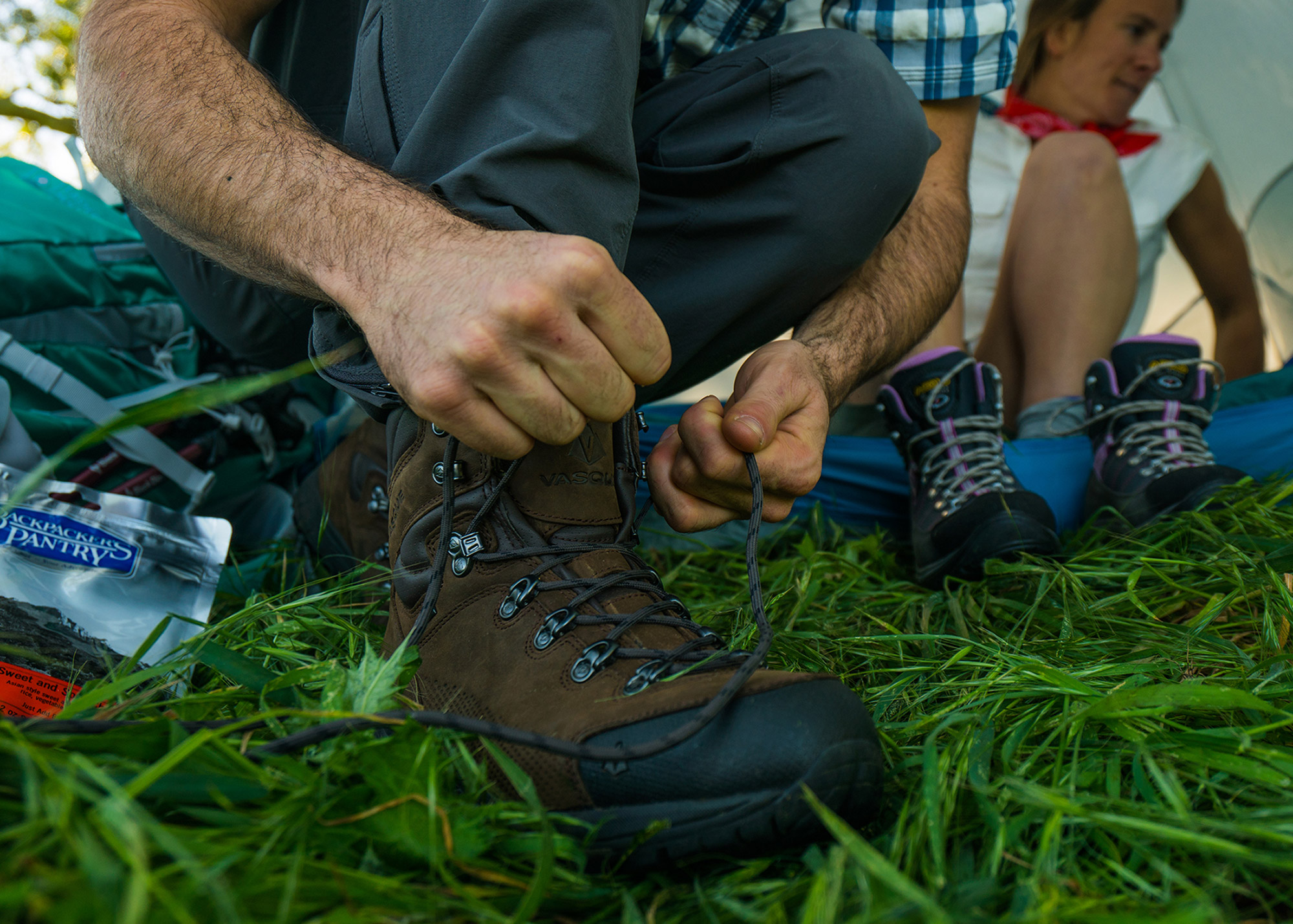Your footwear might be the single most crucial piece of gear that comes wit
Your footwear might be the single most crucial piece of gear that comes with you on a hike. The interface between you and the trail, your sneakers, boots, sandals, or other shoes (alongside your socks) protect you from whatever’s on the ground, keep you comfortable as you move across it, help support your load, make it easier to move across the terrain, and more. So, naturally, there are tons of footwear options out there for hikers. Finding the right one for you is a little bit like dating: choosing the right features, components, and fit is a time-consuming and research-intensive process. But if you do a lot of hiking, having your dream shoes will keep you moving farther, faster, more comfortably, and safer. So where should you begin?
READ MORE: How to Choose Socks

What to Look For in Hiking Footwear
The “boot wall” at your local EMS can be an intimidating thing—shoes of all different shapes and sizes, colors and materials, weird “GTX” letters in the name, and more. Knowing your way around some of these different features and characteristics will help you narrow down your options and pick the right boot for what you want to do.
Height
Each type of hiking footwear hits a slightly different place on your ankle, and even a few inches can make a big difference in your comfort and ease of movement, but the best height for you depends heavily on the terrain you plan on hiking, how much weight you plan to carry, and your personal preference.
High-cut boots extend well above your ankles and do a good job of supporting them and preventing injury. Especially if you’re carrying a heavy load (like when you’re backpacking), or on a rougher trail, they help avoid rolling ankles, and other strains to those joints. They also help stop dirt from getting into your shoes.
Low-cut shoes—which don’t extend very high at all and fit like sneakers—are lightweight and easy to pack. They’re good for well-maintained trails where you won’t be carrying much weight and want to move quickly with as little weight on your shoes as possible.
Mid-cut boots are the best of both worlds: ideal for when you’ll be carrying some weight in your backpack, and/or when you need a little more ankle support to hike in dubious conditions.
Waterproofing
The difference between waterproof and non-waterproof boots is pretty self-explanatory: Waterproof boots will help keep your feet dry splashing through puddles and mud, or skipping across streams. However, when wearing a waterproof boot, you will sacrifice some breathability, so on a hot dry day, your feet are more likely to feel damp from sweat in a waterproof shoe than they would in a non-waterproof shoe. Also, keep in mind that the waterproof membrane in footwear can’t keep you dry if you step in water that “overtops” the boot, and if that happens, a waterproof membrane could make it harder for your shoes to drain that water than they would without a membrane.
GO: Waterproof Shoes | Non-Waterproof Shoes
READ MORE: Maintaining Your Waterproof Shoes and Boots

Materials
Most hiking shoes and boots are made with a combination of nylon and split-grain leather or suede. These boots are lightweight and consequently less expensive, and they also are easy to break in. Other hiking boots are made of full-grain leather. These are durable, heavy, and sturdy, but take longer to break in and will feel a little stiffer on your feet (at least at first).
Outsole and Midsole
The outsole of a shoe or boot is the bottom of the boot—the part that touches the ground. Outsoles have different types of lugs or grooves to help you grip the terrain. A shoe or boot’s midsole is in the middle of the shoe and affects flexibility, stiffness, and cushion. Most lightweight hiking shoes have a soft sole that lets your foot wrap around uneven terrain on easy, short hikes, but soft-sole boots won’t be comfortable if you’re carrying a lot of weight. Hard-sole backpacking and mountaineering boots are the way to go for any trip that’s more intense. Because the soles are stiff and strong, these boots can handle extreme terrain and help you carry lots of weight—but as a trade-off, the lack of flexibility might hurt your feet.
Also, pay attention to the material that makes up the outsole. Firmer, more durable rubbers will last longer in all sorts of terrain, but softer, stickier rubber will grip rock and other surfaces better, giving you greater traction.
Upper and Lacing
The upper of a hiking shoe or boot is the part that covers your toes, the top of your foot, the sides of your foot, and the back of your heel. As you consider which hiking shoe to purchase, you’ll want to make sure the upper is very durable and also breathable—check to see whether it’s made of a lightweight (but still sturdy) material that will let air circulate around your foot. The upper of a hiking boot is also the part with the laces. Look for locking eyelets and sturdy laces to get a precise fit, especially on taller, stiffer boots.
Crampon-compatibility
Most mountaineering boots are crampon compatible. If you’ll be hiking and climbing in snow or ice, you may want to purchase a pair of crampons to attach to your boots. Crampons with a semi-rigid construction and horizontal frames are the best choice to attach to leather hiking boots. For simply walking in the snow, lightweight crampons will work fine. More strenuous activities such as waterfall ice climbing call for steel crampons that can handle tough terrain.

Types of Hiking Footwear
There are a handful of broad categories for hiking footwear, all of which feature a specific combination of the features above which make them well-suited for a specific activity. Keep in mind: None of these options are only good for a single activity. While some may be better suited for a specific type of hiking, you’re not locked in.
Trail Running Shoes
Trail running shoes are actually a type of running shoe—they look more like sneakers than hiking boots—but they work just as well for short hikes, too. They typically have a very grippy outsole and are durable, making them ideal for any type of hike, even terrain that’s more technical. Trail running shoes are reinforced for extra protection, especially around the toe area. Like many types of shoes, you can choose a pair that has extra cushioning or one that’s more minimalist. Compared to other boot types, these are super light, making them as popular for short hikes as they are with long-distance hikers.
Light Hiking Shoes
Low-cut, lightweight hiking shoes are excellent for novice hikers not carrying a lot of weight or for anyone who’s planning a short day hike on flat terrain. Most hiking shoes are lightweight and flexible. However, they’re more durable and sturdy than trail running shoes. Some are waterproof with an extra lining while others focus on breathability, circulating air around your foot through a mesh upper. Hiking shoes are generally fairly painless to break in.
Day Hiking Boots
Hiking boots are different from hiking shoes in two big ways: They hit higher on the ankle and they have a stiffer construction, offering more protection. Hiking boots are more protective and supportive, but they’re also heavier than hiking shoes. Wear them when you’re heading out on a hike with lots of weight on your back. Hiking shoes are durable, but not quite as sturdy as backpacking boots.

Backpacking Boots
Backpacking boots have a high ankle cut and are durable, stiff, and supportive, which makes them great for hikes when you have a long way to go and a lot to carry. Good for just about any kind of terrain and any kind of weather, backpacking boots have aggressive outsoles (sometimes with a place for snowshoes or crampons to attach) and need to be purchased well before your hiking trip so you can break them in.
Mountaineering Boots
Planning to hit the outdoors and do some ice climbing or snowshoeing? Mountaineering boots are the best choice for you. Tall, stiff, and insulated, mountaineering boots are designed for extreme conditions and extreme activities in ice and snow. Most mountaineering boots are meant to be used with crampons.
Performance Sandals
Performance sandals are made for rafting and other summertime adventures. Their textured no-slip sole grips the ground, allowing you to take short hikes with no problem. Make sure you find a pair of sandals that have good toe protection and that are easily drainable.
Approach Shoes
Approach shoes are almost like a cross between hiking boots, climbing shoes, and trail running shoes. Their sticky rubber sole means they’re best used for anything “approaching” rock climbing destinations, so if you anticipate doing some bouldering or rappelling on your hike, wear some approach shoes to help you tackle the terrain leading up to the bouldering problems. Approach shoes are comfortable and okay for long distances, but not good for rough terrain or when carrying lots of weight.
GO: Trail Running Shoes | Light Hiking Boots | Backpacking Boots | Mountaineering Boots | Multi-Sport Sandals

Trying Hiking Footwear On
It can be hard to truly get a feel for a pair of shoes if you’re trying them on in-store, but there are still some things you can do to see how they’ll perform on the trails.
First, come prepared. When you go shopping, wear or bring the socks you’re planning to hike in, and also bring along any insole or footbed inserts you might use. Second, walk or even jog around the store. Walk up and down a set of stairs or a ramp if you can. Finally, make sure the shoes have enough space for your toes, that they provide good arch support, and that your heel doesn’t lift or move (if it does, you’ll get painful blisters). Try different lacing techniques to dial in the perfect fit for your foot shape.
After purchasing the shoes, wear them around your house or try taking them on a short, easy test hike so you can be absolutely sure they’ll work for what you need.
Be prepared to break in your new shoes or boots—this is another good reason to take a test hike before the big day. Listen to your feet and put in the time: a quick fix—such as soaking your boots—probably won’t be a lasting one.
h you on a hike. The interface between you and the trail, your sneakers, boots, sandals, or other shoes (alongside your socks) protect you from whatever’s on the ground, keep you comfortable as you move across it, help support your load, make it easier to move across the terrain, and more. So, naturally, there are tons of footwear options out there for hikers. Finding the right one for you is a little bit like dating: Choosing the right features, components, and fit is a time-consuming and research-intensive process. But if you do a lot of hiking, having your dream shoes will keep you moving farther, faster, more comfortably, and safer. So where should you begin?
READ MORE: How to Choose Socks

What to Look For in Hiking Footwear
The “boot wall” at your local EMS can be an intimidating thing—shoes of all different shapes and sizes, colors and materials, weird “GTX” letters in the name, and more. Knowing your way around some of these different features and characteristics will help you narrow down your options and pick the right boot for what you want to do.
Height
Each type of hiking footwear hits at a slightly different place on your ankle, and even a few inches can make a big difference in your comfort and ease of movement, but the best height for you depends heavily on the terrain you plan on hiking, how much weight you plan to carry, and your personal preference.
High-cut boots extend well above your ankles and do a good job of supporting them, preventing injury. Especially if you’re carrying a heavy load (like when you’re backpacking), or on a rougher trail, they help avoid rolling ankles, and other strains to those joints. They also help stop dirt from getting into your shoes.
Low-cut shoes—which don’t extend very high at all and fit like sneakers—are lightweight and easy to pack. They’re good for well-maintained trails where you won’t be carrying much weight and want to move quickly with as little weight on your shoes as possible.
Mid-cut boots are the best of both worlds: ideal for when you’ll be carrying a some weight in your backpack, and/or when you need a little more ankle support to hike in dubious conditions.
Waterproofing
The difference between waterproof and non-waterproof boots is pretty self-explanatory: Waterproof boots will help keep your feet dry splashing through puddles and mud, or skipping across streams. However, when wearing a waterproof boot, you will sacrifice some breathability, so on a hot dry day, your feel are more likely to feel damp from sweat in a waterproof shoe than they would in a non-waterproof shoe. Also keep in mind that the waterproof membrane in footwear can’t keep you dry if you step in water that “overtops” the boot, and if that happens, a waterproof membrane could make it harder for your shoes to drain that water than they would without a membrane.
GO: Waterproof Shoes | Non-Waterproof Shoes
READ MORE: Maintaining Your Waterproof Shoes and Boots

Materials
Most hiking shoes and boots are made with a combination of nylon and split-grain leather or suede. These boots are lightweight and consequently less expensive, and they also are easy to break-in. Other hiking boots are made of full-grain leather. These are durable, heavy, and sturdy, but take longer to break-in and will feel a little stiffer on your feet (at least at first).
Outsole and Midsole
The outsole of a shoe or boot is the bottom of the boot—the part that touches the ground. Outsoles have different types of lugs or grooves to help you grip the terrain. A shoe or boot’s midsole is in the middle of the shoe and affects flexibility or stiffness and cushion. Most lightweight hiking shoes have a soft sole that lets your foot wrap around uneven terrain on easy, short hikes, but soft-sole boots won’t be comfortable if you’re carrying a lot of weight. Hard-sole backpacking and mountaineering boots are the way to go for any trip that’s more intense. Because the soles are stiff and strong, these boots can handle extreme terrain and help you carry lots of weight — but as a trade-off, the lack of flexibility might hurt your feet.
Also pay attention to the material that makes up the outsole. Firmer, more durable rubbers will last longer in all sorts of terrain, but softer, stickier rubber will grip rock and other surfaces better, giving you greater traction.
Upper and Lacing
The upper of a hiking shoe or boot is the part that covers your toes, the top of your foot, the sides of your foot, and the back of your heel. As you consider which hiking shoe to purchase, you’ll want to make sure the upper is very durable and is also breathable—check to see whether it’s made of a lightweight (but still sturdy) material that will let air circulate around your foot. The upper of a hiking boot is also the part with the laces. Look for locking eyelets and sturdy laces to get a precise fit, especially on taller, stiffer boots.
Crampon-compatibility
Most mountaineering boots are crampon compatible. If you’ll be hiking and climbing in snow or ice, you may want to purchase a pair of crampons to attach to your boots. Crampons with a semi-rigid construction and horizontal frames are the best choice to attach to leather hiking boots. For simply walking in the snow, lightweight crampons will work fine. More strenuous activities such as waterfall ice climbing call for steel crampons that can handle tough terrain.

Types of Hiking Footwear
There are a handful of broad categories for hiking footwear, all of which feature a specific combination of the features above which make them well-suited for a specific activity. Keep in mind: None of these options are only good for a single activity. While some may be better-suited for a specific type of hiking, you’re not locked-in.
Trail Running Shoes
Trail running shoes are actually a type of running shoe—they look more like sneakers than hiking boots—but they work just as well for short hikes, too. They typically have a very grippy outsole and are a durable shoe, making them ideal for any type of hike, even terrain that’s more technical. Trail running shoes are reinforced for extra protection, especially around the toe area. And like many types of shoe, you can choose a pair that has extra cushioning or one that’s more minimalist. Compared to other boot types, these are super light, making them as popular for short hikes as they are with long-distance hikers.
Light Hiking Shoes
Low-cut, lightweight hiking shoes are excellent for novice hikers not carrying a lot of weight or for anyone who’s planning a short day hike on flat terrain. Most hiking shoes are lightweight and flexible. However, they’re more durable and sturdy than trail running shoes. Some are waterproof with an extra lining while others focus on breathability, circulating air around your foot through a mesh upper. Hiking shoes are generally fairly painless to break in.
Day Hiking Boots
Hiking boots are different from hiking shoes in two big ways: They hit higher on the ankle and they have a stiffer construction, offering more protection. Hiking boots are more protective and supportive, but they’re also heavier than hiking shoes. Wear them when you’re heading out on a hike with lots of weight on your back. Hiking shoes are durable, but not quite as sturdy as backpacking boots.

Backpacking Boots
Backpacking boots have a high ankle cut and are durable, stiff, and supportive, which makes they great for the hikes when you have a long way to go and a lot to carry. Good for just about any kind of terrain and any kind of weather, backpacking boots have aggressive outsoles (sometimes with a place for snowshoes or crampons to attach) and need to be purchased well before your hiking trip so you can break them in.
Mountaineering Boots
Planning to hit the outdoors and do some ice climbing or snowshoeing? Mountaineering boots are the best choice for you. Tall, stiff, and insulated, mountaineering boots are designed for extreme conditions and extreme activities in ice and snow. Most mountaineering boots are meant to be used with crampons.
Performance Sandals
Performance sandals are made for rafting and other summertime adventures. Their textured no-slip sole grips the ground, allowing you to take short hikes with no problem. Make sure you find a pair of sandals that has good toe protection and that are easily drainable.
Approach Shoes
Approach shoes are almost like a cross between hiking boots, climbing shoes, and trail running shoes. Their sticky rubber sole means they’re best used for anything “approaching” rock climbing destinations, so if you anticipate doing some bouldering or rappelling on your hike, wear some approach shoes to help you tackle the terrain leading up to the bouldering problems. Approach shoes are comfortable and okay for long distances, but not good for rough terrain or when carrying lots of weight.
GO: Trail Running Shoes | Light Hiking Boots | Backpacking Boots | Mountaineering Boots | Multi-Sport Sandals

Trying Hiking Footwear On
It can be hard to truly get a feel for a pair of shoes if you’re trying them on in-store, but there are still some things you can do to see how they’ll perform on the trails.
First, come prepared. When you go shopping, wear or bring the socks you’re planning to hike in, and also bring along any insole or footbed inserts you might use. Second, walk or even jog around the store. Walk up and down a set of stairs or a ramp if you can. Finally, make sure the shoes have enough space for your toes, that they provide good arch support, and that your heel doesn’t lift or move (if it does, you’ll get painful blisters). Try different lacing techniques to dial in the perfect fit for your foot shape.
After purchasing the shoes, wear them around your house or try taking them on a short, easy test hike so you can be absolutely sure they’ll work for what you need.
Be prepared to break in your new shoes or boots — this is another good reason to take a test hike before the big day. Listen to your feet and put in the time: A quick fix—such as soaking your boots—probably won’t be a lasting one.
Hailey Hudson
Hailey Hudson is a full-time freelance writer based out of the north Georgia mountains. She enjoys reading, tap dancing, and snuggling with her beagle puppy, Sophie. Due to some medical problems, Hailey can't hike and travel as much as she used to, but she still loves being outdoors and exploring new places.




